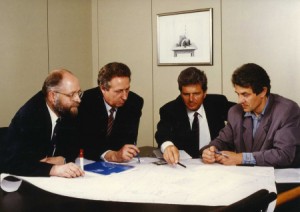[Full disclosure: SAP has not been a client in many years, and then my work with them was quite limited.]
I’ve always had a warm spot in my heart for SAP. When I published my first (and thus far only) 700+ page book in 1994 (“Human Resource Management and Information Technology: Achieving A Strategy Partnership”), Klaus Tschira, one of SAP’s founders, became a big fan of my work, and me of his.
Early on, Klaus understood and believed in the power of object models and object-oriented development as well as in the importance of strategic HRM (so going a lot further than merely administrative improvements in HRM), and he translated those views into SAP’s HCM products over the many years that he led HCM product strategy and development. Our friendship started because we were simpatico when it came to enterprise software.
But it was while I was in Phoenix in 1995 to speak at SAPPHIRE that I saw Klaus’ great humanity. My father collapsed while I was at SAPPHIRE, and I raced home to be with him. Klaus gave my presentation for me, making sure that I didn’t feel I was dropping the ball on him and SAP, for which I always will be grateful. My Dad never regained consciousness, but I was with him and able to support my sister and Mom through the difficult end-of-life decisions facing us — and to do so without any professional guilt. So, even when I’m being critical of some aspect of SAP’s products, leadership, business practices, etc., I’m rooting for their survival and success.
Therefore, amidst all the discussion yesterday about the latest major organizational changes at SAP (and there have been many such over the years I’ve been following SAP), I kept looking for the silver lining. No surprise that Lars decided to leave as many had predicted this. And no surprise that SAP is betting on HANA; what else should they do? Sad that their track record with HR leaders is so poor, but it’s even sadder that there are no highly visible women in SAP’s executive ranks. But what really troubled me was that, not only via SAP’s own communications but also across the twitterverse and blogosphere, there was very little discussion of what SAP really needs to do in order to restore this giant of the last generation of business applications to being a successful competitor for the next generation. And while I tweeted my thoughts on this yesterday, I felt they deserved a blog post of their own.
I believe that SAP needs a coherent and comprehensive next generation true SaaS applications strategy across all their product domains, and then to have delivered on this yesterday. And since delivery yesterday isn’t possible, then they need to deliver on this at the earliest possible moment. While innovative development platforms and databases are powerful and potentially disruptive, applications since run the world, now with embedded analytics, mobile delivery, built-in collaboration and social everything, and the speed of in-memory to unleash the predictive analytics which are our collective future. So, as SAP’s huge installed base of on-premise customers, but more importantly customers lacking the needed applications foundations for success in the 21st century, make the move to true SaaS (or more specifically to SaaS InFullBloom) in order to reap the significant business benefits of doing so, SAP must be ready to compete again for every single one of these customers.
Once upon a time, Business ByDesign was supposed to be that next generation, but that doesn’t seem to have panned out, and ByD has been relegated to the lower end of the market after much architectural reworking and without a very strong HRMS/TM capability. And then, after buying the very expensive SuccessFactors, we were told that SAP’s next generation true SaaS offering would be some combination of SuccessFactors for TM, a greatly upgraded and rearchitected Employee Central (and the metadata framework thus introduced is a very good start) for HRMS, a hosted rendition of SAP’s workhorse global payroll (now rebranded “cloud” payroll), some extrapolation of ByD’s financials and many more bits and pieces that lay well beyond my areas of expertise. But in my opinion, that’s not good enough. SAP’s customers, and SAP itself, deserve a lot more.
I think it’s time for SAP to pick an architecture, development platform, database, object models and everything else that’s needed in the foundation and then to bring to market a whole new applications suite. If HANA is that architecture, development platform, database and more of the needed foundation, that would be terrific. But even if that’s true, even if everything else we need as to effective-dating, inheritance, security, etc. etc. is contained within HANA, even if HANA provides a fully models-driven, metadata-rich, definitional development environment, there’s still a lot of heavy lifting needed to develop next generation object models across all the applications domains served by SAP. And then those next generation applications must be reincarnated or built fresh on top of those object models within HANA.
That sounds like a ton of work, so I’m hoping that much of this is already done and just needs some pulling together. But wherever SAP is on the road to fulfilling the next generation dreams of their current customers and of the market, there’s not a moment to lose. As for me, I’m hoping yesterday’s organizational changes make this happen ASAP.
